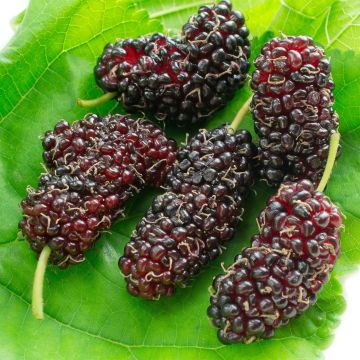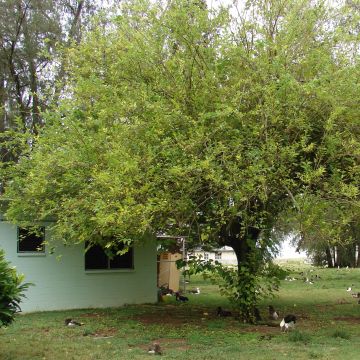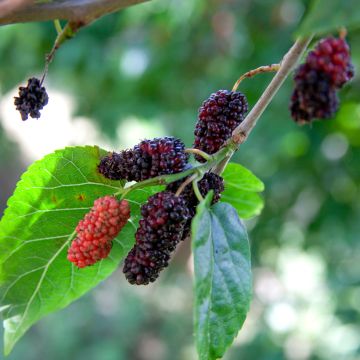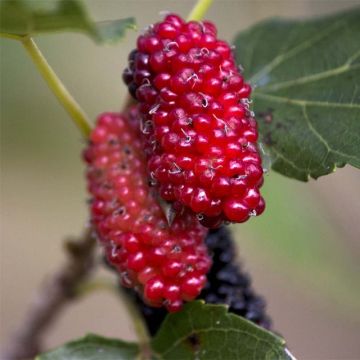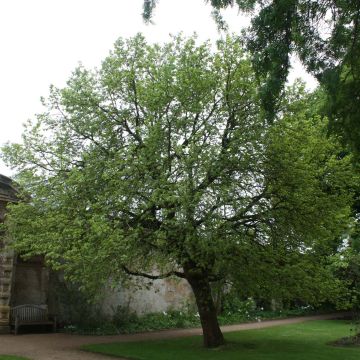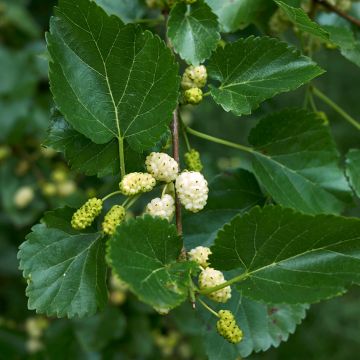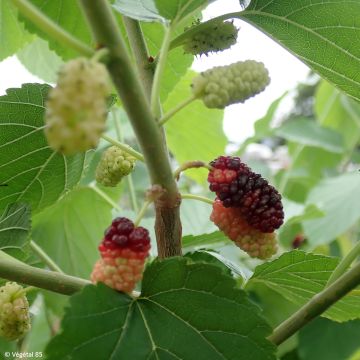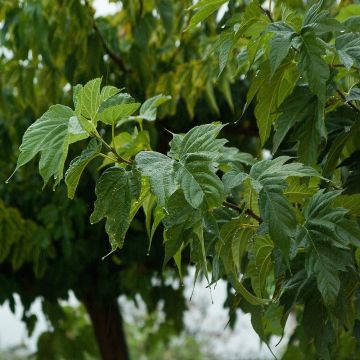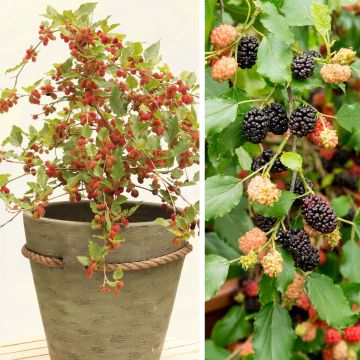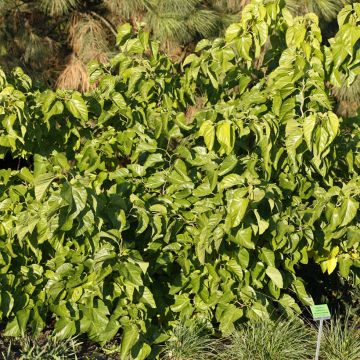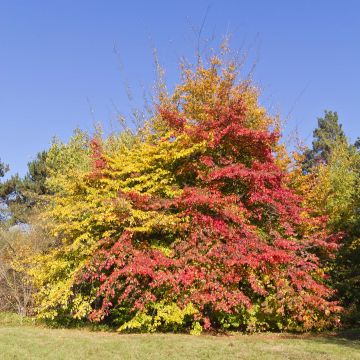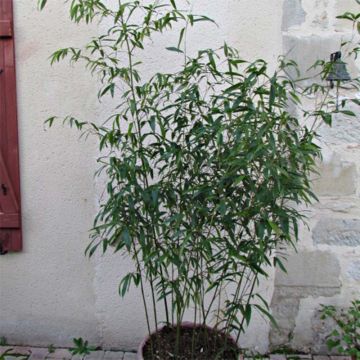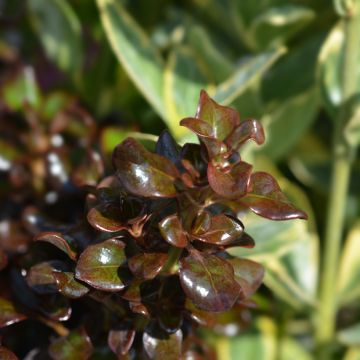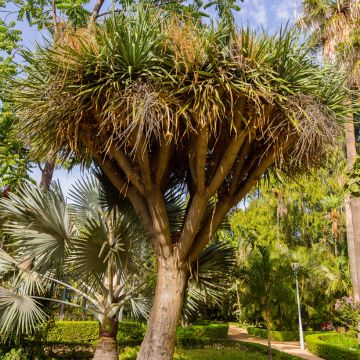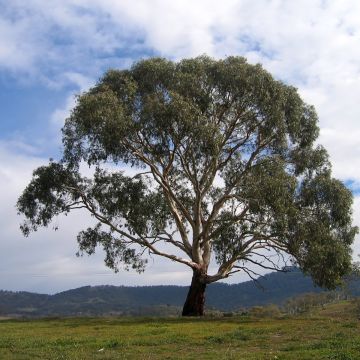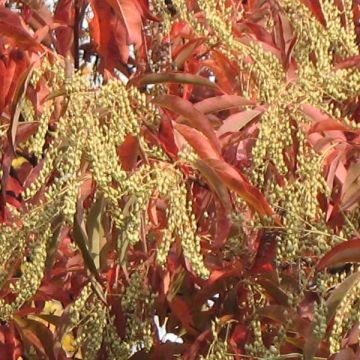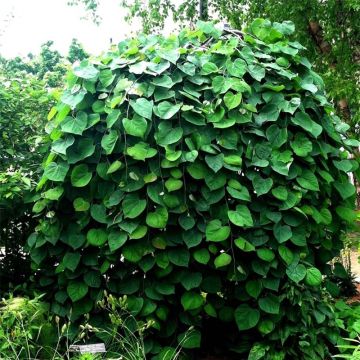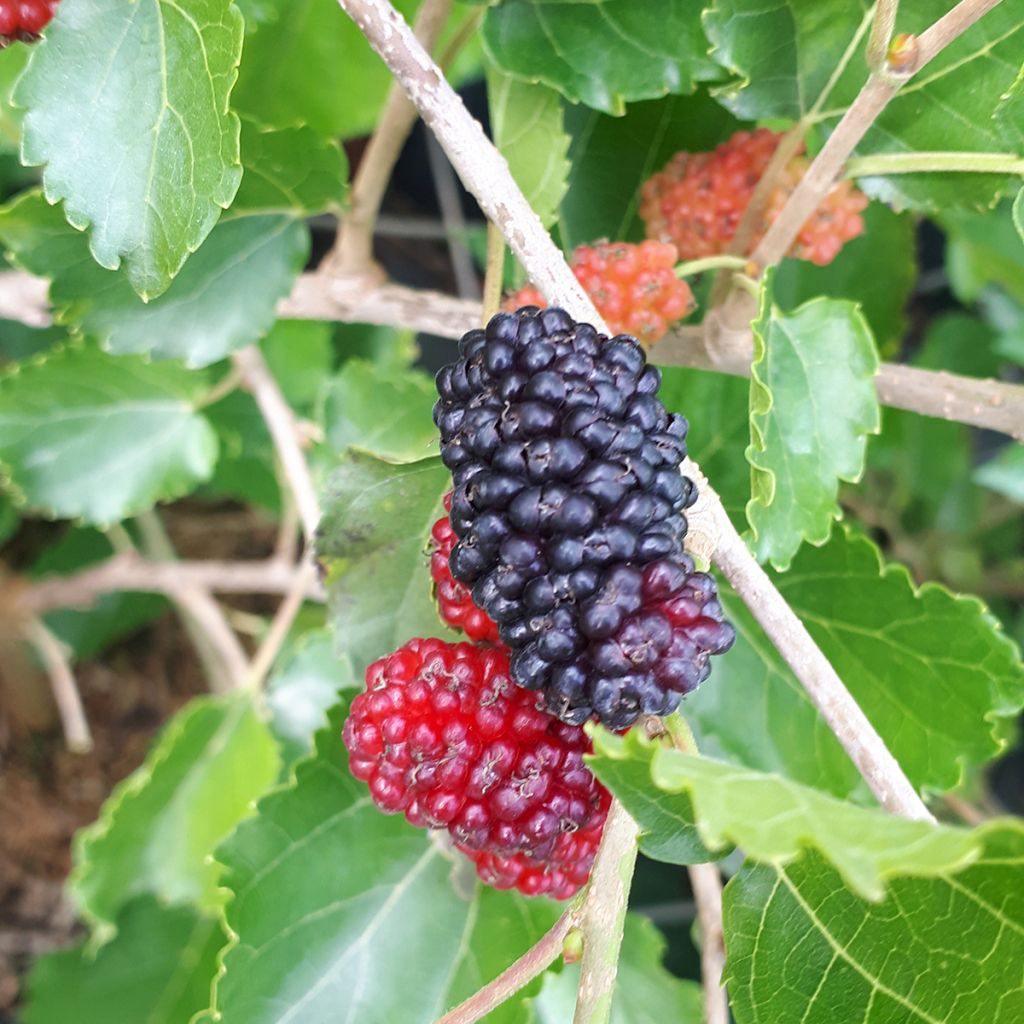

Morus alba Milanowek - White Mulberry
Morus alba Milanowek - White Mulberry
Morus alba Milanowek
White Mulberry
This item cannot be shipped to the selected country
Delivery charge from €5.90
More information
Schedule delivery date,
and select date in basket
This plant carries a 24 months recovery warranty
More information
We guarantee the quality of our plants for a full growing cycle, and will replace at our expense any plant that fails to recover under normal climatic and planting conditions.
From €5.90 for pickup delivery and €6.90 for home delivery
Express home delivery from €8.90.
Does this plant fit my garden?
Set up your Plantfit profile →
Description
Morus alba 'Milanovek' is a selection of White Mulberry of Polish origin sought after for its cold resistance and productivity. The tree produces large, elongated, black fruits that have a sweet flavour when ripe. This variety is also known for its long fruiting period, from June to September: its branches bear fruits of different colours, giving the vegetation a real ornamental value. Like all mulberries, 'Milanovek' is an excellent shade tree. It is very hardy and also resistant to heat and drought.
The 'Milanovek' mulberry belongs to the Moraceae family. Like all trees in this botanical family, it produces latex in its tissues. Mature specimens, which retain the memory of many pollarding prunings, often have a hollow, twisted trunk that is truly picturesque.
Morus 'Milanowek' is a tree with a short, thick trunk, topped by a spreading crown that can be somewhat irregular if not pruned. It is more commonly seen shaped into a rounded and compact head after pruning. Its growth is rapid during the first few years and then slows down. It can reach between 6 and 10m in all directions. Its light grey bark cracks to become thicker, and then turns grey-brown. The deciduous leaves are polymorphous, meaning their appearance can vary depending on their position on the branches. They measure 6 to 8cm in diameter, 10 to 20cm in length, and are alternate, petiolate, either simple and heart-shaped, or divided into 3 to 7 more or less deep lobes, with an irregularly toothed margin. The upper surface of the leaf is shiny and light green, turning golden yellow in autumn. The White Mulberry develops male or female flowers in different locations on the same tree in March-April. Its discreet flowering consists of male or female catkins composed of tiny green-yellow flowers. In June-July, the female flowers produce fleshy fruits, measuring up to 10cm long. Their colour changes from green to white, then to pink, red, and purple, almost black when ripe. They are edible and loved by birds. The root system of this tree, both taproot and running, does not tolerate transplanting well. Its strength means it should be planted at a respectable distance from buildings. Its lifespan can reach or even exceed 150 years.
Morus alba 'Milanowek' grows in fertile, well-worked, and well-drained soil in a sunny location. It tolerates pollution well but is not suitable for coastal areas or areas with salt spray. Uncultivated land benefits from its presence, as its leaves gradually enrich the soil each autumn. Traditionally used as a street tree, it can also be planted in a fruit hedge, for example, alongside blackthorns, mirabelle plums, medlars, viburnums, and dogwoods, much to the delight of birds. It can also be an interesting specimen planted alone in the middle of a lawn. Avoid planting it near a terrace, as its fruits can stain the ground. It can also be used to shade a chicken coop, as the fallen fruits will be eaten by the chickens. Its leaves are food for silkworms and can be used as fodder for rabbits.
The fruits of the 'Milanowek' white mulberry are consumed fresh or cooked. They are much sweeter than the fruits of the black mulberry, and they contain vitamins C, D, and E, as well as iron. They can be eaten raw, used to make jams and jellies, or used as a topping for pies. They add a touch of sweetness to summer salads and fruit salads. Their flavour pairs well with blackberries (wild blackberry or cultivated blackberry) and stone fruits such as apricots, plums, and peaches. Those who enjoy sweet and savoury combinations can use them to accompany pork, duck, or game. They also pair well with basil, mint, baking spices, arugula, cream, mascarpone, or mixed with citrus fruits.
Report an error about the product description
Plant habit
Flowering
Foliage
Botanical data
Morus
alba
Milanowek
Moraceae
White Mulberry
Morus indica 'Milanówek'
Eastern Europe
Other Morus - Mulberry
Planting and care
Morus alba 'Milanowek' should be planted in spring or autumn in well-drained, fertile and deep soil, not too chalky or too acidic, and in full sun. Be careful not to damage its fleshy and brittle roots during planting. It tolerates cold weather perfectly and withstands hot and dry summers once well-rooted. Prune to maintain a beautiful habit. It may be subject to rust, hemp or powdery mildew, in which case treat with copper.
Planting period
Intended location
Care
This item has not been reviewed yet - be the first to leave a review about it.
Striking foliage shrubs
Haven't found what you were looking for?
Hardiness is the lowest winter temperature a plant can endure without suffering serious damage or even dying. However, hardiness is affected by location (a sheltered area, such as a patio), protection (winter cover) and soil type (hardiness is improved by well-drained soil).

Photo Sharing Terms & Conditions
In order to encourage gardeners to interact and share their experiences, Promesse de fleurs offers various media enabling content to be uploaded onto its Site - in particular via the ‘Photo sharing’ module.
The User agrees to refrain from:
- Posting any content that is illegal, prejudicial, insulting, racist, inciteful to hatred, revisionist, contrary to public decency, that infringes on privacy or on the privacy rights of third parties, in particular the publicity rights of persons and goods, intellectual property rights, or the right to privacy.
- Submitting content on behalf of a third party;
- Impersonate the identity of a third party and/or publish any personal information about a third party;
In general, the User undertakes to refrain from any unethical behaviour.
All Content (in particular text, comments, files, images, photos, videos, creative works, etc.), which may be subject to property or intellectual property rights, image or other private rights, shall remain the property of the User, subject to the limited rights granted by the terms of the licence granted by Promesse de fleurs as stated below. Users are at liberty to publish or not to publish such Content on the Site, notably via the ‘Photo Sharing’ facility, and accept that this Content shall be made public and freely accessible, notably on the Internet.
Users further acknowledge, undertake to have ,and guarantee that they hold all necessary rights and permissions to publish such material on the Site, in particular with regard to the legislation in force pertaining to any privacy, property, intellectual property, image, or contractual rights, or rights of any other nature. By publishing such Content on the Site, Users acknowledge accepting full liability as publishers of the Content within the meaning of the law, and grant Promesse de fleurs, free of charge, an inclusive, worldwide licence for the said Content for the entire duration of its publication, including all reproduction, representation, up/downloading, displaying, performing, transmission, and storage rights.
Users also grant permission for their name to be linked to the Content and accept that this link may not always be made available.
By engaging in posting material, Users consent to their Content becoming automatically accessible on the Internet, in particular on other sites and/or blogs and/or web pages of the Promesse de fleurs site, including in particular social pages and the Promesse de fleurs catalogue.
Users may secure the removal of entrusted content free of charge by issuing a simple request via our contact form.
The flowering period indicated on our website applies to countries and regions located in USDA zone 8 (France, the United Kingdom, Ireland, the Netherlands, etc.)
It will vary according to where you live:
- In zones 9 to 10 (Italy, Spain, Greece, etc.), flowering will occur about 2 to 4 weeks earlier.
- In zones 6 to 7 (Germany, Poland, Slovenia, and lower mountainous regions), flowering will be delayed by 2 to 3 weeks.
- In zone 5 (Central Europe, Scandinavia), blooming will be delayed by 3 to 5 weeks.
In temperate climates, pruning of spring-flowering shrubs (forsythia, spireas, etc.) should be done just after flowering.
Pruning of summer-flowering shrubs (Indian Lilac, Perovskia, etc.) can be done in winter or spring.
In cold regions as well as with frost-sensitive plants, avoid pruning too early when severe frosts may still occur.
The planting period indicated on our website applies to countries and regions located in USDA zone 8 (France, United Kingdom, Ireland, Netherlands).
It will vary according to where you live:
- In Mediterranean zones (Marseille, Madrid, Milan, etc.), autumn and winter are the best planting periods.
- In continental zones (Strasbourg, Munich, Vienna, etc.), delay planting by 2 to 3 weeks in spring and bring it forward by 2 to 4 weeks in autumn.
- In mountainous regions (the Alps, Pyrenees, Carpathians, etc.), it is best to plant in late spring (May-June) or late summer (August-September).
The harvesting period indicated on our website applies to countries and regions in USDA zone 8 (France, England, Ireland, the Netherlands).
In colder areas (Scandinavia, Poland, Austria...) fruit and vegetable harvests are likely to be delayed by 3-4 weeks.
In warmer areas (Italy, Spain, Greece, etc.), harvesting will probably take place earlier, depending on weather conditions.
The sowing periods indicated on our website apply to countries and regions within USDA Zone 8 (France, UK, Ireland, Netherlands).
In colder areas (Scandinavia, Poland, Austria...), delay any outdoor sowing by 3-4 weeks, or sow under glass.
In warmer climes (Italy, Spain, Greece, etc.), bring outdoor sowing forward by a few weeks.

































